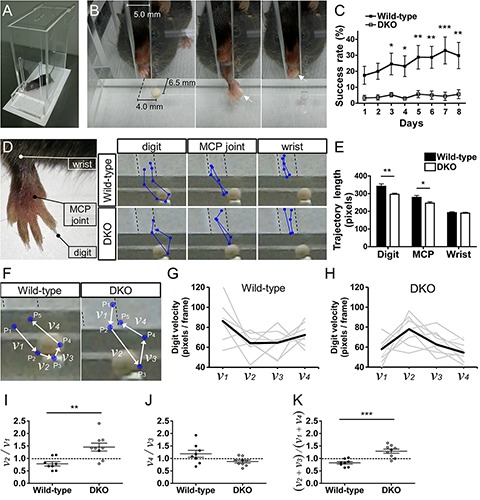FIGURE 9.

Single pellet-reaching task. (A) Apparatus for the single pellet-reaching task. (B) In a successful reach, a mouse extends a forelimb through the slit, grasps a pellet in a divot, and brings it to its mouth (arrows). (C) Rate of successful reaching during eight test sessions. The wild-type mice (n = 8) showed improvements in the success rate over time [F(7,49) = 3.19, P = 0.0072], whereas the Sulf1/2 DKO mice (n = 10) showed a lower success rate throughout the test period [F(7,63) = 0.749, P = 0.63]. As a result, the success rates of the DKO mice were lower than those of the wild-type mice after the third session. (D,E) Trajectory analysis of the forelimb in the successful reaches. The positions of the distal tip of the second digit, second metacarpophalangeal (MCP) joint, and wrist were marked in the video (D, blue dots) to analyze the reaching trajectories. Representative trajectories (blue lines) in the wild-type and Sulf1/2 DKO mice are shown. The dotted lines indicate the position of the slit. The trajectory length of the digit and MCP joint was shorter in the Sulf1/2 DKO mice (n = 9) than in the wild-type mice (n = 8) (E). (F–K) Velocity analysis of the forelimb in successful reaches. The positions of the distal tip of the second digit in the five consecutive frames (P1–P5) in a successful reach, in which P3 corresponds to the points of pellet grasping, were marked in the video, and the velocity between 2 points (v1 to v4) was measured (F). In the wild-type mice, v2 and v3 were smaller than v1 and v4, respectively (G,I–K). In contrast, in the Sulf1/2 DKO mice, v2 and v3 were larger than v1 and v4, respectively (H–K). Statistical significance was calculated using one-way and two-way repeated-measures ANOVA with a Bonferroni post hoc test in (C,E) and a Mann–Whitney U test in (I–K). ∗P < 0.05, ∗∗P < 0.01, ∗∗∗P < 0.001. Data shown are means ± SEMs.
